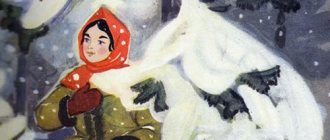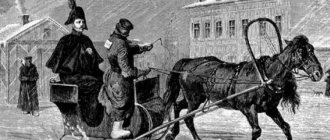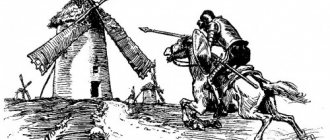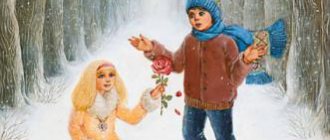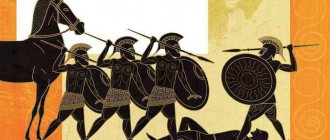- Essays
- On literature
- Other
- Heroes of the fairy tale Thumbelina
There is only one main character in the fairy tale - Thumbelina herself. The rest of the characters can be considered secondary. There are quite a lot of secondary characters: a woman, a witch, a toad with her son, a moth, a cockchafer, a field mouse, a mole, a swallow, and the king of the elves. Each of the minor characters played a more or less significant role in the life of the main character.
Thumbelina is a tiny girl who was born from a flower. Thumbelina's cradle was a walnut shell. Thumbelina's favorite pastime while she lived at home was riding on a large tulip petal that floated in a plate. It was like riding a boat. Thumbelina also loved to sing.
Thumbelina's fate is not easy. She is very pretty, her appearance is attractive. That's why she is kidnapped more than once. Mothers predict her as a bride for their sons. But it never came to a wedding; weddings were always upset. This continued until Thumbelina flew to a hot country, where she met the king of the elves.
Thumbelina is very kind, she is capable of pity and sympathy and is able to help. Thumbelina is capable of truly loving, she is looking for love and finds it at the end of the fairy tale.
Minor characters
The woman , Thumbelina's adoptive mother, was childless and dreamed of children. The woman turned to the old witch for advice and help. When Thumbelina was born, the woman began to look after her with maternal care. Nothing more is known about this heroine.
Witch
Thumbelina emerged from a flower. And the flower grew from a grain that the witch gave to the woman who approached her, who dreamed of having children. Apart from the fact that the sorceress helped the woman who became Thumbelina’s adoptive mother, nothing is said about the sorceress.
Toads: mother and son
The toad played a fatal role in Thumbelina's life. She became the first of those who kidnapped Thumbelina.
This toad was huge, scary, wet. So was her son, whom the mother toad planned to marry Thumbelina. Both mother and son seemed disgusting and disgusting to Thumbelina. If the toad's plans had come true, Thumbelina would have had to live in the mud for the rest of her days.
Butterfly
The role of the Moth in the fate of Thumbelina is fleeting. When Thumbelina, thanks to a lucky chance, managed to break free and escape from the toad and her son, and she was floating on a water lily leaf along the river, the moth was just flying by. He saw Thumbelina and flew up to her. Thumbelina put a belt on the moth so that it would pull the water lily leaf faster. Almost immediately after this, Thumbelina is carried away by the cockchafer, and the unfortunate moth, tied to the leaf, floats on with the leaf. What happened to him next is unknown. Maybe he was freed, maybe not. Thumbelina was then tormented by the thought that she could have caused the death of the Moth, albeit involuntarily, but this did not make it any easier for her.
Chafer
Another kidnapper. The cockchafer has no opinion of his own. What matters to him is not what he himself thinks, but what others say. At the moment when he kidnapped Thumbelina, he liked her. But after his friends discussed her and said that she was ugly, the beetle also began to consider her ugly, even ugly. He left Thumbelina alone and flew away.
Harvest mouse
A wealthy person. Reasonable, sober-minded. Thumbelina is looking for a rich groom - a mole.
Mole
A very boring person. A sedate, respectable gentleman. He is rich and has a good education. Has a spacious house with no light. He is not interested in flowers and sunshine. The mole is blind. The main occupation is digging the ground. Likes to do all sorts of calculations. It is clear that she and Thumbelina are not a couple.
On the wedding day, Thumbelina runs away from the Mole.
Martin
First, Thumbelina saves the Swallow, and then the Swallow saves Thumbelina.
The swallow injured its wing and was unable to fly south in the fall. If it weren't for Thumbelina, she would have frozen. Thumbelina came out. The swallow was able to return to her normal life.
The swallow carries Thumbelina to the country where Thumbelina begins a new, happy life.
Elf King
Tiny, gentle, no different in courage. But a gallant gentleman. He immediately invites Thumbelina to become his wife. Thumbelina agrees.
The King of the Elves found the name Thumbelina ugly and gave Thumbelina a new name - Maya.
Main characters
Thumbelina | A miniature girl who was born from a flower pot. From the first days of her life, troubles and dangers await the tiny girl. A small, defenseless girl was stolen by a toad, then she was carried away by a cockchafer. For a long time, Thumbelina starved and died of cold. She spent a whole year underground, in a mouse hole, working for her mistress - a mouse. Finally, Thumbelina was lucky: the Swallow took her to distant lands, where the little girl met an elf and became his wife. |
Analysis of the fairy tale Thumbelina
A bright, kind fairy tale about the heroine’s search for her happiness carries a positive charge. Although the heroine does not have a clear goal, the little defenseless girl does not look submissive and resigned. She resists troubles and fights them, even helping others in trouble. With her kindness, ability to endure, wait and hope, the heroine deserved happiness. The main idea of the fairy tale Thumbelina can be expressed by the apt proverb “A kind heart attracts happiness.” Because good comes back in kind. What does the fairy tale Thumbelina teach? You should not submit to the will of others, you need to look for your own path to happiness.
Thumbelina is a character from the fairy tale of the same name by Hans Christian Andersen.
You know that every fairy tale teaches something. What can the fairy tale “Thumbelina” by Hans Christian Andersen teach us?
Imagine a lot! A child, meeting a very small girl, learns to live in this huge and sometimes scary world. Let's go on a journey through a magical land created by the imagination of a brilliant storyteller, and learn life lessons from it.
One woman, a witch and Thumbelina
One woman dreamed of having a child and went to a witch. Why didn’t she give birth to a child herself, or adopt an orphan? After all, this is what those who dream of children usually do. However, there is a category of people who cannot cope with their problems on their own. They resort to the services of sorcerers, magicians, witches, and psychics.
The point here is that such a person has desires, but no abilities, creative imagination, or vital energy. This poor woman cannot even come up with a normal name for the girl; she is not able to ensure the baby’s safety, carelessly leaving a nutshell with the sleeping girl by the open window.
It is quite natural that she lost her happiness.
A witch is an image of a person, on the contrary, who has the ability to create. She has the power to create something fantastic, spiritual and animate from something ordinary, for example from a grain of barley. But still, a witch is a simple person, not an omnipotent God, so the wonderful creature turned out to be very small.
Thumbelina, born by the power of creative imagination, has beauty and talent. She is able to give all living beings joy and happiness. But it is so small that it cannot exist independently in the material world. Her charm extends only to the spiritual component of reality.
This is her salvation and at the same time a test - she is always needed by someone and at the same time dependent on someone. Thumbelina is a symbolic character; she represents something beautiful, but unattainable in real life, because no one has managed to possess her in this world.
Only in a distant country did this happen to the king of the elves, a creature as fantastic as Thumbelina herself.
Toad, her son and Thumbelina
The toad, having stolen Thumbelina, was somewhat more prudent than its former owner; she placed the treasure on a piece of paper, far from the shore, to prevent the potential daughter-in-law from escaping. And yet, having stereotypical thinking, she could not imagine that there were other forces that could interfere with her plans: swimming fish, for example.
Even the thought that someone is ready to help the unfortunate creature does not occur to the toad. In addition, she does not think that her son as a husband can make anyone unhappy. And the worst thing is that the toad is busy building a family nest in a swampy swamp, in which Thumbelina cannot survive.
But the old toad cannot understand all this. What can you learn here? At least the fact that every act is complicated by many circumstances, some can be foreseen and prevented, while others, due to human limitations, are impossible. There are people who do not have an adequate understanding of the world, themselves and those around them.
Everything they do ends in failure sooner or later.
The toad's son is an absolutely spineless creature. If they found him a bride, he will marry; if they had not found him, he would not have married. This is the image of a person who has no personal beginning at all. It is unlikely that he was very upset after the loss of his bride.
He doesn't need a wife at all.
Are there many such families that appeared thanks to the active efforts of third parties? Are they happy? Or maybe, somewhere in the swamp mud of a cozy family nest, built by a “caring” mother-in-law, a “thumbelina” dies, which no one helped.
Our heroine found herself on a water lily leaf in the middle of the river and was terribly scared.
How can a person behave in such a situation? She could have thrown a scandal at the toad and her son, she could have rushed about in hysterics over the leaf and loudly called for help, scattering the timid fish with her cries, she could have thrown herself into the river in a fit of despair and drowned.
This is usually how people behave when they find themselves in a hopeless situation. But Thumbelina behaves differently: having completely resigned herself to her fate, she bitterly and quietly mourns her ruined life.
The fish, seeing this, took pity on her and gnawed the stem holding Thumbelina’s flower. And the leaf carried the beautiful captive away from the ugly toads. They say that pity humiliates a person, as we see, it does not humiliate, but saves. It is the meek who are usually lucky - they are willingly helped.
They also help the beautiful ones. This is what happened to the white moth, enchanted by the beauty of Thumbelina. He allowed her to tie himself with a belt to a leaf, for which he paid with his life. What can we talk about here? Probably about the fact that you cannot be so attached to something that it would be impossible to free yourself.
Beetle and Thumbelina
The culprit in the death of the moth was the cockchafer. But he didn’t even think with the corner of his consciousness that it was his fault that someone died, and grief wasn’t enough for him.
The cockchafer was not devoid of aesthetic taste, and he really liked the little beauty. But then other cockchafers came and expressed their opinion: “She only has two legs!”, “She doesn’t even have tentacles!” And the beetle refused Thumbelina. Why did this happen?
Firstly, the cockchafer is an egoist who considers himself worthy of all the best; he takes from life everything he likes, while being dependent on other people’s opinions.
This is a representative of the fashion crowd, for whom the worst thing is to be different from “their own”, to be not like everyone else. The value of anything for such people is measured not by their own ideas, but by how others evaluate it.
The fairy tale “Thumbelina” gives us an understanding of the terrible evil that lies in giving up love for the sake of public opinion.
Secondly, a beetle is not a suitable husband for Thumbelina. He has stereotypical thinking, and this prevents him from being independent even in being happy.
Even a hundred thousand cockchafers could not have given him even a fraction of the spiritual joy that one Thumbelina could have given him.
He prefers his external position among worthless and narrow-minded relatives to the internal state of happiness and love.
Thumbelina, abandoned by the beetle, developed a sense of her own inferiority.
How often does this happen in life, when a wonderful, sweet, very good person considers himself defective only because he is rejected by insignificant creatures, who for some reason known to them are confident in their superiority.
And Thumbelina doesn’t even allow the thought that they are biased towards her. This character is admired for his inability to think badly of others. She only blames herself.
Mouse, Mole and Thumbelina
Rejected by the beetle, Thumbelina lived alone all summer and autumn. But then winter comes, and the poor girl is forced to look for shelter.
A field mouse took her in to live with her. This kind creature loves Thumbelina, takes care of her and wishes her only happiness. Therefore, she is busy trying to marry Thumbelina to the mole. She herself sees this marriage as the height of a prosperous life, since the mole is rich and has a luxurious fur coat.
For a mouse, these reasons are enough to consider the mole an eligible bachelor. In this case, she takes upon herself the right to decide someone else’s fate, guided exclusively by good intentions, and does this completely disinterestedly.
The example of a mouse shows how some people can make other people unhappy, wishing only good things for them, showing sincere care for a loved one. Truly, “the road to hell is paved with good intentions.”
The mole is the personification of a rich man. His character is given in a few words: “important, sedate and taciturn.” He considers himself the height of every girl’s dream, but does not like the sun, flowers and birds - everything that Thumbelina adores - a character opposed to the mole in its very essence. This marriage is doomed from the start.
Thumbelina in this situation is true to herself: she unquestioningly obeys her adoptive mother, considering her her benefactor. Only at the last moment does he decide to escape, because he cannot imagine his life without sunlight.
Swallow, the King of the Elves and Thumbelina
Getting rid of a miserable existence in a mole dungeon became possible thanks to the swallow, who was warmed and saved from starvation by Thumbelina. The character in the form of a swallow is the link between the heroine of the fairy tale and another world, contrasted with ordinary and boring reality.
The mole and the mouse, who devote their lives to accumulating material wealth, unanimously accuse the bird of a useless existence. For them, birdsong is a completely empty activity. And for Thumbelina it is a great joy. She takes care of the bird as a sign of gratitude for the moments of pleasure she once brought.
And the swallow saved Thumbelina, knowing full well that escape is salvation, and life with the mole is death.
The world into which the swallow and her little passenger were transported is a holiday of warmth, light and beauty. There Thumbelina meets her destiny - the king of the elves. Finally, she feels at home, with her family. Born from a flower, she becomes the queen of flowers. She achieved her happiness, having earned it by overcoming all obstacles without causing harm to anyone.
The elf king is Thumbelina's first groom, who asks her consent to marriage. It occurred to him alone to ask her opinion.
And when the elves surrounded Thumbelina and saw the absence of wings, they simply gave them to her without further ado. This is how all problems should be solved in an ideal society, which is embodied by elves; it is customary for them to respect each other and take care of the personality of another creature. This example is the main life lesson that can be learned from the fairy tale “Thumbelina”.
Thumbelina, a character until this moment nameless, this definition based on height cannot be considered a name, receives her real name - Maya. Thus, a new symbol is born - the embodiment of spring, warmth and light.
Source: https://FB.ru/article/262951/dyuymovochka—personaj-odnoimennoy-skazki-gansa-hristiana-andersena
Thumbelina
Once in Denmark, from the blossoming bud of a flower, a girl no larger than a human finger was born.
Thumbelina did not live in her mother's house for even two days - soon the heroine had to go on an incredible journey, in which she became acquainted with the good and evil of this world.
Everyone knows who wrote the fairy tale about the tiny girl since kindergarten. The magical story of Hans Christian Andersen is not only read to children, but also plays are staged with children.
History of creation
The tale of Thumbelina came to Danish children in 1835 as part of the collection “Fairy Tales Told for Children.” When exactly the magical story about the travels of a little girl was written remains a mystery. Andersen did not publish new works for a long time - he put them off for editing.
Hans Christian Andersen
When creating the character, the author took inspiration from legends about the little people, and even Charles Perrault’s character Thumb was on a wave of popularity.
But Thumbelina can also boast of a real prototype - it was Henrietta Wulf, the daughter of the Danish translator of Shakespeare and Byron. A short, hunchbacked woman with an angelic character was friends with Hans.
The prototype was also found in the mole: they say that the storyteller copied this character from a strict school teacher.
Henrietta Wolf - prototype of Thumbelina
The published work did not cause admiration among critics. The writers were dissatisfied with the simplicity of the language of presentation and the lack of moralizing, because in those days edifying notes and pronounced morality were valued. But readers enthusiastically accepted Andersen’s new fairy tale, and this is more important than the assessments of literature experts.
For ten years, “Thumbelina” was read exclusively by residents of their native country. It was only in 1846 that the adventures of the little girl managed to travel abroad. They were translated into English and then into other European languages.
Thumbelina in a flower
And everywhere the character was called differently. For example, in her homeland the heroine of the fairy tale was called Tommelise, which translated means “an inch-sized fox”, in England and France - Tambelina and Puselina (both translated as thumb on the hand), and in the Czech Republic simply - Malenka.
The character reached Russian readers, as always, late. At the end of the 19th century, the spouses Peter and Anna Hansen began adapting the fairy tales of the Danish writer, carefully preserving elements of the originals. In the first translation, the girl’s name was Lizok-a-vershok; she later turned into Thumbelina.
Biography and plot
One middle-aged, lonely woman dreamed of children, but fate deprived her of the joy of motherhood. The fairy volunteered to help, handing over a barley grain from which a beautiful flower grew.
At the core of the bud was a little girl no larger than a human finger.
The woman made a cradle for her daughter from a walnut shell, but the happiness was short-lived - one day a toad noticed Thumbelina and decided to steal her to marry her son.
Thumbelina and the Toad
The road to the toad's house ran through the lake, along which the unfortunate girl was carried on a water lily leaf. The fish, taking pity on the slave, gnawed the stem of the water lily, and the moth rushed away the makeshift boat.
However, along the way, Thumbelina was again captured, this time by the cockchafer. On the tree, the kidnapper's brothers did not appreciate the appearance of the find - the girl seemed very ugly to the beetles, and they decided to abandon the heroine in the forest to the mercy of fate.
Thumbelina and the beetles
The warm spring and summer flew by quickly. With the arrival of the first autumn frosts, Thumbelina went in search of shelter and came across a field mouse hole. The hostess warmly accommodated her guest, although she forced her to work. And then, taking a closer look, she saw in the girl an excellent bride for her old and blind, but wealthy mole neighbor.
Thumbelina and the Mole
While walking around the groom's underground domain, Thumbelina came across a lifeless swallow. It turned out that the bird did not die, but simply lost strength from the frost.
Because of the girl’s care and attention, the swallow came to life and on the day of her wedding with the mole, she took the savior to a land where it is always sunny and warm. Here the tiny beauty met the prince of the elves - the same height and good appearance.
The prince proposed marriage to the traveler. So Thumbelina became queen in the land of elves and acquired a new name - Maya.
Thumbelina and the Elf Prince
The thought that the author put into the work concerns the search for purpose and one’s place in life. In this, the fairy tale echoes another literary work of Hans Christian Andersen - “The Ugly Duckling”.
The characteristics of the heroes are simple and clear. The writer put certain traits and vices into each, and the result was a whole world with motley inhabitants.
The toad becomes the personification of greed and envy, beetles convey the idea of the insignificance of public opinion - everyone has their own concept of beauty.
Pisces have cunning and ingenuity, the stupid but kind mouse is a symbol of frugality and puritanism, and the mole, although rich, is stingy.
Thumbelina flies on a swallow
The fragile and tender Thumbelina showed courage, patience, and steadfastly endured the trials that befell her.
But among the readers there will also be those who see in the main character a weak-willed creature: the girl is not able to influence events, her only independent act is saving the swallow, for which she received a reward in the form of a serene and happy life.
However, according to researchers, at the time the fairy tale was created, a passive type of behavior, the role of a victim of circumstances was considered natural for women.
Film adaptations
Andersen's fairy tale has been rewritten by poets and writers countless times; the young beauty's wanderings around the world are found even in poetry. And, of course, the main characters of the magical adventure appeared in dozens of cartoons, and film directors gave the world four television films.
Thumbelina in the Soviet cartoon
Russian cinema has distinguished itself with two films that have become legends. This is the cartoon "Thumbelina", created by Leonid Amalrik in 1964. The voice of the girl was given by Galina Novozhilova, the mouse was voiced by Elena Ponsova, and the mole by Mikhail Yanshin.
Even Georgy Vitsin worked on the voice acting of the film, in whose voice the Grasshopper spoke.
The cartoon's script differs in some respects from the classic fairy tale: Thumbelina did not receive a new name at the end of the story, the mole made many friends, and a new character appeared - a cancer who helps the fish save the girl from the toad.
Tatyana Vasilishina as Thumbelina
Director Leonid Nechaev presented an interesting interpretation of Andersen’s creation - the 2007 musical film “Thumbelina” received a scattering of prizes at film festivals. The main role was played by Tatyana Vasilishina. The cast included Svetlana Kryuchkova (Toad), Liya Akhedzhakova (Mouse), Leonid Mozgovoy (Mole), Albert Filozov (Maestro).
Thumbelina in Don Bluth's cartoon
The authors of the cartoons gave free rein to their imagination. So, in 1994, Don Bluth made a cartoon in which he deviated from the original plot. For example, the disgusting toad nevertheless married Thumbelina to her son and forced the girl to pursue a career as a pop star, because show business is a profitable business.
Interesting Facts
Thumbelina, along with other fairy tale characters, appears at the wedding of Shrek and Fiona in the cartoon "Shrek 2".
Monument to Thumbelina
The image of a tiny girl served as inspiration for the sculptors. A sculpture is dedicated to the main character of Andersen's fairy tale in Odense (Denmark), depicting the moment when Thumbelina appears in a flower. Outside Denmark, there are also bronze dedications to the heroine of the magical story. So, in 2006, a sculpture of Thumbelina decorated the central alley of the park in Sochi.
Charlotte Garside
In England there lives a girl who was nicknamed Thumbelina. Charlotte Garside entered the Guinness Book of Records as the smallest girl in the world.
She was born with a rare disease - primordial dwarfism. This form of short stature is also characterized by mental retardation.
At the age of five, the child’s height was 68 cm, while Charlotte had the intelligence of a three-year-old baby.
Quotes
The 1964 Soviet cartoon “Thumbelina” is replete with funny phrases. It is not surprising that soon after the film was released they turned into catchphrases:
“Have mercy on me, mistress! Don't marry me to Mole! - You are crazy! You won't find a better husband than our neighbor! A blind, rich man is a treasure, not a husband!” “Half a grain a day... A day is not much. I'm getting married! And per year? There are 365 days in a year. Half a grain a day - 182 and a half grains per year. It turns out not so little per year... No, I won’t get married!” “But you have to feed your wife, and wives, you know, they are voracious.” “Alas, we must part! Because no one liked you except me! I wish you success!” “I don’t want to study, I want to get married!” “Well, we’ve eaten, now we can sleep. Well, we slept, now we can eat.” “Nothing, nothing! They don’t die of happiness!” “- What squalor! - She only has two legs! - She doesn’t even have a mustache!
“She even has a waist!”
"I feel sorry for you! How can you, with your artistic taste, suddenly descend to such squalor?! Oh, spin me around, spin me! "" - Well, is the bride good? - Good! It's just a pity that it's not green.
“It’s okay, if he lives with us, he’ll turn green.”
Source: https://24smi.org/person/1184-diuimovochka.html
Character
Like the Ugly Duckling and some of Andersen's other characters, Thumbelina is an “outsider” character looking for her place in society. Such heroes evoke the author's sympathy.
The plot of the tale
One woman grew a beautiful flower in her garden. One day a woman kissed a bud, after which it burst and a tiny beautiful girl appeared in the flower. The woman named her Thumbelina, since the girl was no larger than a human finger, and began to take care of her.
The girl was very cute. Toad once noticed this. She decided that Thumbelina could be a wonderful match for her son. Having waited until midnight, the toad stole the girl to take her to his son. The toad's son was fascinated by the girl's beauty. To prevent her from running away, he placed Thumbelina on a water lily leaf.
However, to help the girl, the fish brought a hermit crab, which cut the trunk of the lily with its claw (since the fish could not bite through the stem of the water lily), and the Moth, who liked Thumbelina, harnessed herself to her belt and flew, pulling the leaf along the water.
While the Moth was pulling the leaf with Thumbelina, the belt burst, and the toads were about to intercept Thumbelina, but the Maybug intercepted her and carried her to him.
Field Mouse and Thumbelina (illustration for the collection “Young Folks Treasury” (1919))
Zhuk brought Thumbelina to show his acquaintances and friends. But they didn’t like the girl, because beetles had their own ideas about beauty. Zhuk abandoned the girl because he immediately stopped liking her. Poor Thumbelina remained to live in the forest.
She lived like this all summer, autumn passed, and as winter approached, the girl began to freeze. Fortunately, the frozen Thumbelina was discovered by the Field Mouse, who sheltered her in his hole. Then the mouse decided to marry the girl to his rich neighbor, Mole. The mole was very wealthy and equally stingy.
But he liked Thumbelina, and he agreed to think about marriage. The Mole showed Thumbelina his underground “palaces” and riches. In one of the galleries, the girl discovered a dead swallow. However, it turned out that the swallow was simply very weak. Thumbelina, secretly from the Mouse and the Mole, began to take care of her. Spring has come.
The swallow completely recovered and, thanking Thumbelina, flew out of the mole's galleries.
At that time, the mole finally decided on his desire to get married. The mouse ordered the girl to sew her trousseau. Thumbelina was very sad and offended, because she really didn’t want to marry Mole. The wedding day has arrived.
Thumbelina decided to go out into the light for the last time and say goodbye to the sun. At that moment, the same Swallow flew over the fields.
She took Thumbelina with her to warmer climes, thereby saving her from the stingy and calculating Mole.
In warm regions, Thumbelina settled in a flower. She met the king of the flower elves, who was as small as Thumbelina herself. The Elf and Thumbelina immediately fell in love with each other and became husband and wife. So Thumbelina became the queen of the elves.
Screen adaptations and productions
- Andrew Lang retitled this tale "The Adventures of Maya" in his eleventh volume of Tales of the Olive Fairy (published 1907).
- The first Thumbelina film was in black and white and was released in 1924 by director Herbert M. Doley.
- Danny Kaye performed the song "Thumbelina", written by Frank Loesser, in the 1952 film about Andersen.
- Lotte Reiniger released a short 10-minute film about Thumbelina in 1954.
- In 1964, the Soviet cartoon “Thumbelina” by Leonid Amalrik was filmed.
- Filmstrip Thumbelina, 1972
- Japanese studio Toei Animation released a feature-length anime film in 1978, titled Sekai Meisaku Dowa: Oyayubi Hime (World's Famous Children's Stories: The Thumb Princess), with animation by artist Osamu Tezuka.
- The series about Thumbelina, for home viewing, was released by the Faerie Tale Theater studio in 1984, with the participation of Carrie Fisher and William Katt.
- The story, with colorful artwork by Rabbit Ears Productions, was released in 1989 on videotape, audiodisc, compact cassette (narrated by Kelly McGillis), and book.
- The Japanese studio Enoki Films released a 26-episode cartoon in 1992 called Oyayubi Hime Monogatari (Tales of Thumbelina).
- Golden Films produced a cartoon about Thumbelina (1993).
- In 1994, Don Bluth released a cartoon about Thumbelina, which has some deviations from the classic author's plot.
- In 2002, the cartoon “The Adventures of Thumbelina and Little Thumb” was released on DVD.
- Thumbelina appeared as a guest at Princess Fiona's wedding in the animated film Shrek 2 (2004).
- Hans Christian Andersen's 200th Anniversary: The Fairy Tales, 2005, Denmark, The Netherlands, Jorgen Bing (Hans Christian Andersen. Fairy Tales, 2005, Denmark, The Netherlands, Jorgen Bing)
- In 2007, the film “Thumbelina” by Leonid Nechaev was released based on the script by Inna Vetkina.
- In 2009, the cartoon Barbie Presents the Fairy Tale "Thumbelina" was released.
see also
- Thumb Boy
- Funny men
Notes
- ↑
Website of the magazine “Funny Pictures”
Links
Wikisource has the full text of the fairy tale “Thumbelina”
- “Thumbelina” on prosto-skazka.rf
Thumbelina, Thumbelina Disney, Thumbelina pictures, Thumbelina cartoon, Thumbelina cartoon, Thumbelina fairy tale, Thumbelina listen, Thumbelina watch, Thumbelina photos, Thumbelina read
